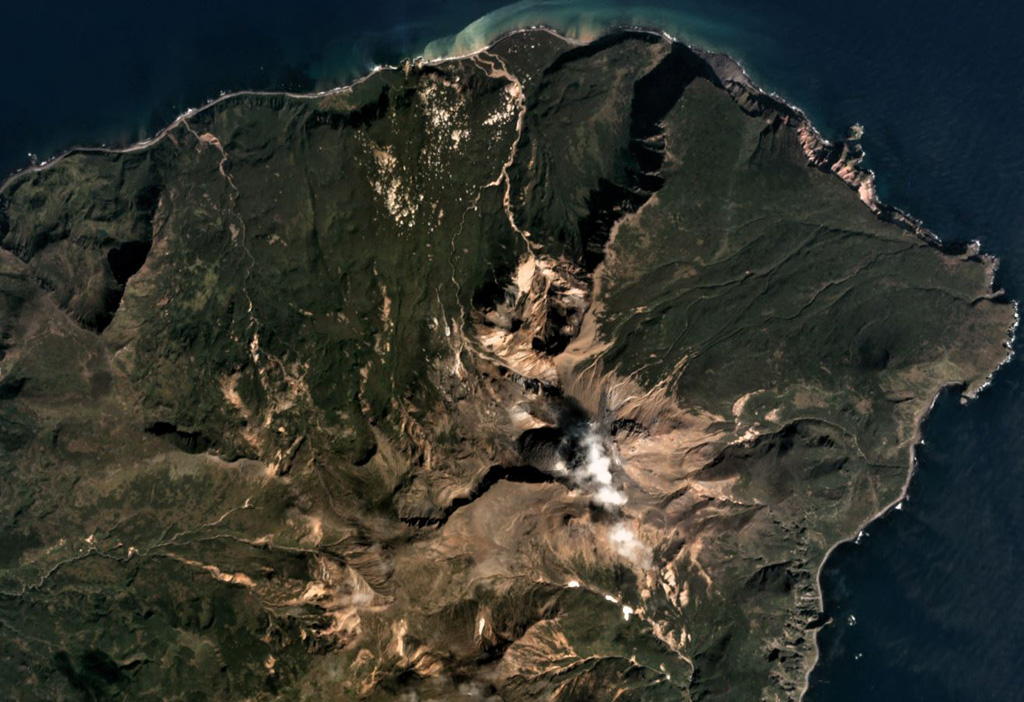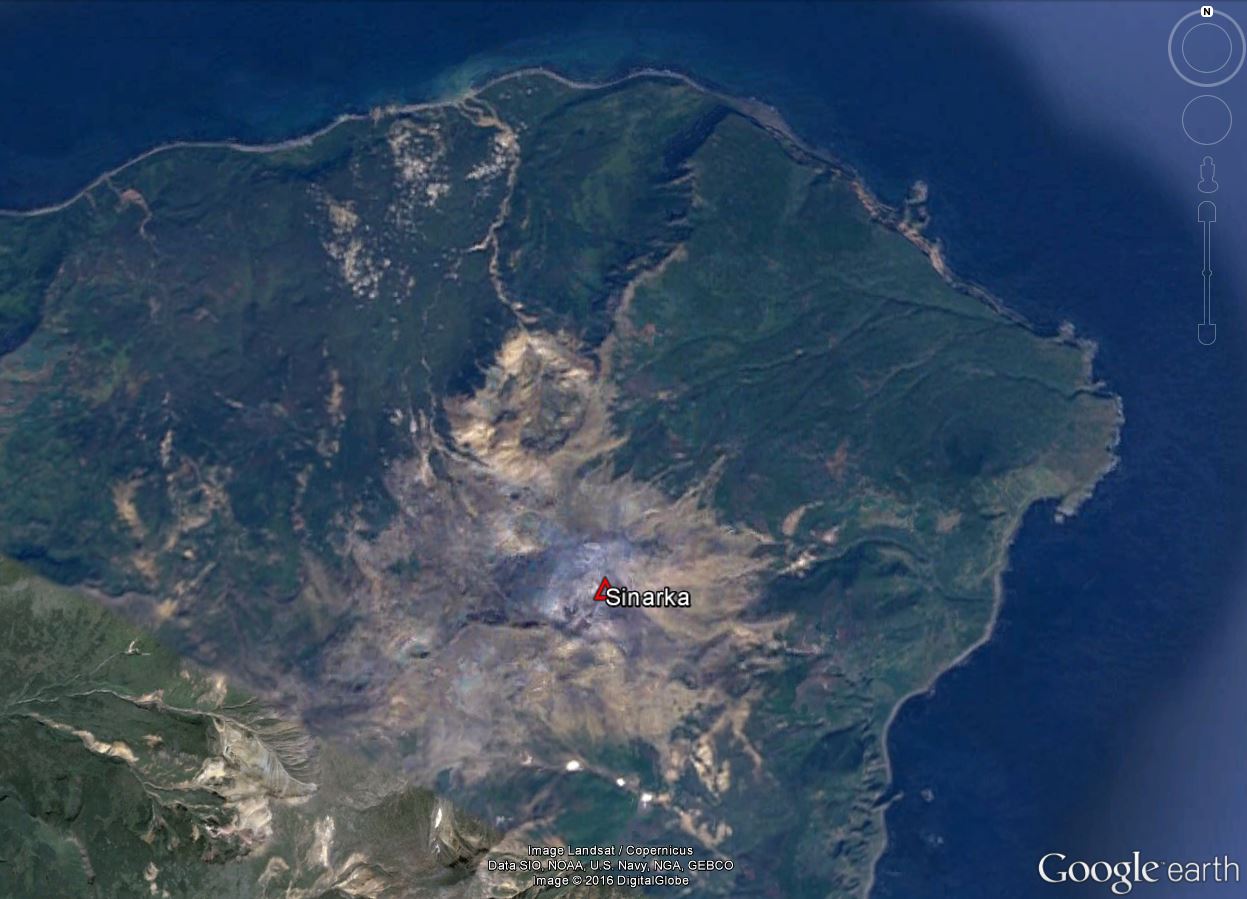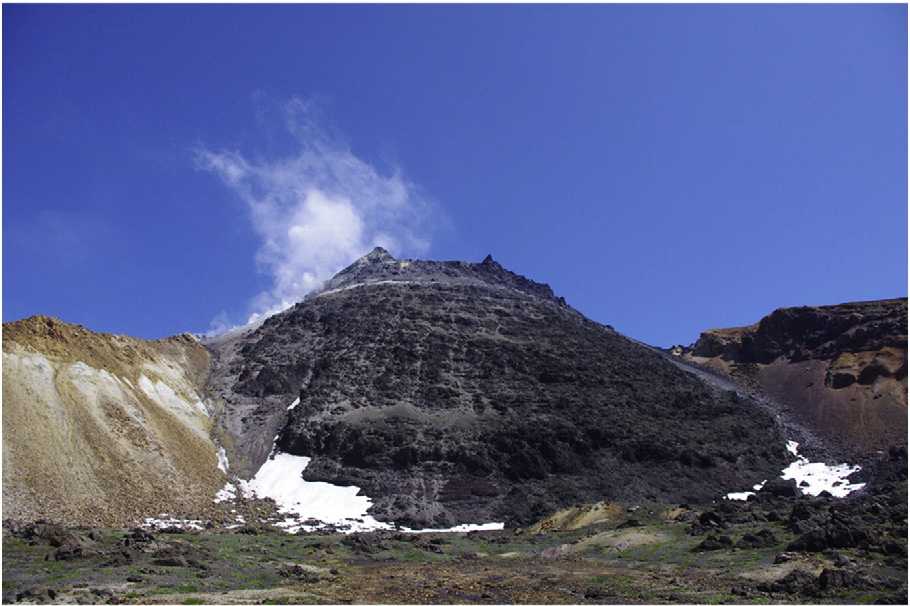

SVERT reported that satellite images showed steam-and-gas emissions from Sinarka on 16 March and a weak thermal anomaly on 21 March.
Source: Sakhalin Volcanic Eruption Response Team (SVERT)
Stronger thermal activity during November 2014-March 2015; possible minor ash emission
The hydrothermally-active Sinarka volcano (figure 1) is located on the NE end of the dumbbell-shaped island of Shiashkotan, in the Kuril Islands chain, with Kuntomintar in the south (figure 2). Kalacheva et al. (2015) note that the extrusive dome within the central cone exhibits degassing through strong and hot (over 400°C) fumaroles (figure 3). Much of the time the volcano is obscured by clouds from satellite observations, but it is monitored by the Sakhalin Volcanic Eruption Response Team (SVERT).
 |
Figure 1. Landsat / Copernicus satellite image showing Sinarka volcano at the NE end of Shiashkotan Island. Courtesy of Google Earth. |
 |
Figure 3. Photo of the lava dome within the central cone of Sinarka. From Kalacheva et al. (2015); photo by Elena Kalacheva. |
The Sakhalin Volcanic Eruption Response Team (SVERT) noted volcanic activity at Sinarka between 11 November 2014 and 21 March 2015 (table 1). The primary observations were of a weak thermal anomaly combined with weak steam-and-gas plumes seen in satellite imagery. Plumes sometimes drifted as far as 40-50 km downwind. The cause of the anomalies is unknown. However, on 3 December 2014 the plume reportedly contained minor ash.
Table 1. Summary of activity observed at Sinarka volcano from November 2014 to June 2016. Courtesy of Sakhalin Volcanic Eruption Response Team (SVERT).
| Date | Activity | Aviation Color Code |
| 11 Nov 2014 | Weak steam/gas plume drifting 40 km E. | Yellow |
| 12 Nov 2014 | Strengthening steam/gas plume drifting NE; weak thermal anomaly. | Yellow |
| 16 Nov 2014 | Weak thermal anomaly. | Yellow |
| 19 Nov 2014 | Weak steam/gas plume. | Yellow |
| 27 Nov 2014 | Steam/gas plume drifting 50 km SE. | Yellow |
| 03 Dec 2014 | Minor ash with steam/gas plume drifting 40 km NE. | Yellow |
| 06 Dec 2014 | Weak steam/gas plume. | Yellow |
| 08 Dec 2014 | Weak steam/gas plume. | Yellow |
| 05 Jan 2015 | Steam/gas plume to 3 km drifting SE. | Yellow |
| 26 Jan 2015 | No activity detected in January. | Green |
| 16 Mar 2015 | Weak steam/gas plume. | Green |
| 21 Mar 2015 | Weak thermal anomaly. | Green |
Reference: Kalacheva, E., Taran, Y., and Kotenko, T., 2015, Geochemistry and solute fluxes of volcano-hydrothermal systems of Shiashkotan, Kuril Islands. Journal of Volcanology and Geothermal Research, v. 296, p. 40-54.
Information Contacts: Sakhalin Volcanic Eruption Response Team (SVERT), Institute of Marine Geology and Geophysics, Far Eastern Branch, Russian Academy of Science, Nauki st., 1B, Yuzhno-Sakhalinsk, Russia, 693022 (URL: http://www.imgg.ru/en/, http://www.imgg.ru/ru/svert/reports).
2015: January
| March
2014: November
| December
SVERT reported that satellite images showed steam-and-gas emissions from Sinarka on 16 March and a weak thermal anomaly on 21 March.
Source: Sakhalin Volcanic Eruption Response Team (SVERT)
SVERT reported that activity at Sinarka was not detected during January; on 26 January the Aviation Color Code was lowered to Green.
Source: Sakhalin Volcanic Eruption Response Team (SVERT)
SVERT reported that steam-and-gas emissions detected in satellite images rose 3 km above Sinarka and drifted SE on 5 January. Cloud cover obscured views on the other days during 6-12 January. The Aviation Color Code remained at Yellow.
Source: Sakhalin Volcanic Eruption Response Team (SVERT)
SVERT reported that on 8 December satellite images of Sinarka showed diffuse steam-and-gas emissions. Cloud cover obscured views on the other days during 9-15 December. The Aviation Color Code was raised to Yellow.
Source: Sakhalin Volcanic Eruption Response Team (SVERT)
SVERT reported that on 3 December satellite images of Sinarka showed steam-and-gas emissions with small amounts of ash drifting 40 km NE. Diffuse steam-and-gas emissions were observed on 6 December. Cloud cover obscured views on the other days during 1-8 December. The Aviation Color Code was raised to Yellow.
Source: Sakhalin Volcanic Eruption Response Team (SVERT)
SVERT reported that on 27 November satellite images of Sinarka showed steam-and-gas emissions drifting 50 km SE. Cloud cover obscured views on the other days during 24 November-1 December. The Aviation Color Code remained at Yellow.
Source: Sakhalin Volcanic Eruption Response Team (SVERT)
SVERT reported that satellite images of Sinarka showed steam-and-gas emissions on 19 November. Cloud cover obscured views on the other days during 17-24 November. The Aviation Color Code was raised to Yellow.
Source: Sakhalin Volcanic Eruption Response Team (SVERT)
SVERT reported that satellite images of Sinarka showed steam-and-gas emissions drifted 40 km E on 11 November. The next day a weak thermal anomaly was detected. Gas-and-steam activity became more robust; emissions drifted NE. A weak thermal anomaly was again detected on 16 November. The Aviation Color Code was raised to Yellow.
Source: Sakhalin Volcanic Eruption Response Team (SVERT)
Reports are organized chronologically and indexed below by Month/Year (Publication Volume:Number), and include a one-line summary. Click on the index link or scroll down to read the reports.
Stronger thermal activity during November 2014-March 2015; possible minor ash emission
The hydrothermally-active Sinarka volcano (figure 1) is located on the NE end of the dumbbell-shaped island of Shiashkotan, in the Kuril Islands chain, with Kuntomintar in the south (figure 2). Kalacheva et al. (2015) note that the extrusive dome within the central cone exhibits degassing through strong and hot (over 400°C) fumaroles (figure 3). Much of the time the volcano is obscured by clouds from satellite observations, but it is monitored by the Sakhalin Volcanic Eruption Response Team (SVERT).
 |
Figure 1. Landsat / Copernicus satellite image showing Sinarka volcano at the NE end of Shiashkotan Island. Courtesy of Google Earth. |
 |
Figure 3. Photo of the lava dome within the central cone of Sinarka. From Kalacheva et al. (2015); photo by Elena Kalacheva. |
The Sakhalin Volcanic Eruption Response Team (SVERT) noted volcanic activity at Sinarka between 11 November 2014 and 21 March 2015 (table 1). The primary observations were of a weak thermal anomaly combined with weak steam-and-gas plumes seen in satellite imagery. Plumes sometimes drifted as far as 40-50 km downwind. The cause of the anomalies is unknown. However, on 3 December 2014 the plume reportedly contained minor ash.
Table 1. Summary of activity observed at Sinarka volcano from November 2014 to June 2016. Courtesy of Sakhalin Volcanic Eruption Response Team (SVERT).
| Date | Activity | Aviation Color Code |
| 11 Nov 2014 | Weak steam/gas plume drifting 40 km E. | Yellow |
| 12 Nov 2014 | Strengthening steam/gas plume drifting NE; weak thermal anomaly. | Yellow |
| 16 Nov 2014 | Weak thermal anomaly. | Yellow |
| 19 Nov 2014 | Weak steam/gas plume. | Yellow |
| 27 Nov 2014 | Steam/gas plume drifting 50 km SE. | Yellow |
| 03 Dec 2014 | Minor ash with steam/gas plume drifting 40 km NE. | Yellow |
| 06 Dec 2014 | Weak steam/gas plume. | Yellow |
| 08 Dec 2014 | Weak steam/gas plume. | Yellow |
| 05 Jan 2015 | Steam/gas plume to 3 km drifting SE. | Yellow |
| 26 Jan 2015 | No activity detected in January. | Green |
| 16 Mar 2015 | Weak steam/gas plume. | Green |
| 21 Mar 2015 | Weak thermal anomaly. | Green |
Reference: Kalacheva, E., Taran, Y., and Kotenko, T., 2015, Geochemistry and solute fluxes of volcano-hydrothermal systems of Shiashkotan, Kuril Islands. Journal of Volcanology and Geothermal Research, v. 296, p. 40-54.
Information Contacts: Sakhalin Volcanic Eruption Response Team (SVERT), Institute of Marine Geology and Geophysics, Far Eastern Branch, Russian Academy of Science, Nauki st., 1B, Yuzhno-Sakhalinsk, Russia, 693022 (URL: http://www.imgg.ru/en/, http://www.imgg.ru/ru/svert/reports).
This compilation of synonyms and subsidiary features may not be comprehensive. Features are organized into four major categories: Cones, Craters, Domes, and Thermal Features. Synonyms of features appear indented below the primary name. In some cases additional feature type, elevation, or location details are provided.
Synonyms |
| Kuro-dake | Aka-dake | Sinarko |
|
|
||||||||||||||||||||||||||
There is data available for 4 confirmed Holocene eruptive periods.
[ 2014 Dec 3 - 2014 Dec 3 ] Uncertain Eruption
| Episode 1 | Eruption | |||||||||||||||||||||||||
|---|---|---|---|---|---|---|---|---|---|---|---|---|---|---|---|---|---|---|---|---|---|---|---|---|---|
| 2014 Dec 3 - 2014 Dec 3 | Evidence from Observations: Reported | ||||||||||||||||||||||||
|
List of 3 Events for Episode 1
| |||||||||||||||||||||||||
1872 - 1878 Confirmed Eruption VEI: 4
| Episode 1 | Eruption | |||||||||||||||||||||||||||||||||||||||||||||
|---|---|---|---|---|---|---|---|---|---|---|---|---|---|---|---|---|---|---|---|---|---|---|---|---|---|---|---|---|---|---|---|---|---|---|---|---|---|---|---|---|---|---|---|---|---|
| 1872 - 1878 | Evidence from Observations: Reported | ||||||||||||||||||||||||||||||||||||||||||||
|
List of 7 Events for Episode 1
| |||||||||||||||||||||||||||||||||||||||||||||
1855 Confirmed Eruption VEI: 2
| Episode 1 | Eruption | ||||||||||||||||||||
|---|---|---|---|---|---|---|---|---|---|---|---|---|---|---|---|---|---|---|---|---|
| 1855 - Unknown | Evidence from Observations: Reported | |||||||||||||||||||
|
List of 2 Events for Episode 1
| ||||||||||||||||||||
1846 Confirmed Eruption VEI: 3
| Episode 1 | Eruption | ||||||||||||||||||||
|---|---|---|---|---|---|---|---|---|---|---|---|---|---|---|---|---|---|---|---|---|
| 1846 - Unknown | Evidence from Observations: Reported | |||||||||||||||||||
|
List of 2 Events for Episode 1
| ||||||||||||||||||||
1725 ± 25 years Confirmed Eruption VEI: 2 (?)
| Episode 1 | Eruption | |||||||||||||||
|---|---|---|---|---|---|---|---|---|---|---|---|---|---|---|---|
| 1725 ± 25 years - Unknown | Evidence from Observations: Reported | ||||||||||||||
|
List of 1 Events for Episode 1
| |||||||||||||||
There is no Deformation History data available for Sinarka.
There is no Emissions History data available for Sinarka.
Maps are not currently available due to technical issues.
There are no samples for Sinarka in the Smithsonian's NMNH Department of Mineral Sciences Rock and Ore collection.
| Copernicus Browser | The Copernicus Browser replaced the Sentinel Hub Playground browser in 2023, to provide access to Earth observation archives from the Copernicus Data Space Ecosystem, the main distribution platform for data from the EU Copernicus missions. |
| MIROVA | Middle InfraRed Observation of Volcanic Activity (MIROVA) is a near real time volcanic hot-spot detection system based on the analysis of MODIS (Moderate Resolution Imaging Spectroradiometer) data. In particular, MIROVA uses the Middle InfraRed Radiation (MIR), measured over target volcanoes, in order to detect, locate and measure the heat radiation sourced from volcanic activity. |
| MODVOLC Thermal Alerts | Using infrared satellite Moderate Resolution Imaging Spectroradiometer (MODIS) data, scientists at the Hawai'i Institute of Geophysics and Planetology, University of Hawai'i, developed an automated system called MODVOLC to map thermal hot-spots in near real time. For each MODIS image, the algorithm automatically scans each 1 km pixel within it to check for high-temperature hot-spots. When one is found the date, time, location, and intensity are recorded. MODIS looks at every square km of the Earth every 48 hours, once during the day and once during the night, and the presence of two MODIS sensors in space allows at least four hot-spot observations every two days. Each day updated global maps are compiled to display the locations of all hot spots detected in the previous 24 hours. There is a drop-down list with volcano names which allow users to 'zoom-in' and examine the distribution of hot-spots at a variety of spatial scales. |
|
WOVOdat
Single Volcano View Temporal Evolution of Unrest Side by Side Volcanoes |
WOVOdat is a database of volcanic unrest; instrumentally and visually recorded changes in seismicity, ground deformation, gas emission, and other parameters from their normal baselines. It is sponsored by the World Organization of Volcano Observatories (WOVO) and presently hosted at the Earth Observatory of Singapore.
GVMID Data on Volcano Monitoring Infrastructure The Global Volcano Monitoring Infrastructure Database GVMID, is aimed at documenting and improving capabilities of volcano monitoring from the ground and space. GVMID should provide a snapshot and baseline view of the techniques and instrumentation that are in place at various volcanoes, which can be use by volcano observatories as reference to setup new monitoring system or improving networks at a specific volcano. These data will allow identification of what monitoring gaps exist, which can be then targeted by remote sensing infrastructure and future instrument deployments. |
| Volcanic Hazard Maps | The IAVCEI Commission on Volcanic Hazards and Risk has a Volcanic Hazard Maps database designed to serve as a resource for hazard mappers (or other interested parties) to explore how common issues in hazard map development have been addressed at different volcanoes, in different countries, for different hazards, and for different intended audiences. In addition to the comprehensive, searchable Volcanic Hazard Maps Database, this website contains information about diversity of volcanic hazard maps, illustrated using examples from the database. This site is for educational purposes related to volcanic hazard maps. Hazard maps found on this website should not be used for emergency purposes. For the most recent, official hazard map for a particular volcano, please seek out the proper institutional authorities on the matter. |
| IRIS seismic stations/networks | Incorporated Research Institutions for Seismology (IRIS) Data Services map showing the location of seismic stations from all available networks (permanent or temporary) within a radius of 0.18° (about 20 km at mid-latitudes) from the given location of Sinarka. Users can customize a variety of filters and options in the left panel. Note that if there are no stations are known the map will default to show the entire world with a "No data matched request" error notice. |
| UNAVCO GPS/GNSS stations | Geodetic Data Services map from UNAVCO showing the location of GPS/GNSS stations from all available networks (permanent or temporary) within a radius of 20 km from the given location of Sinarka. Users can customize the data search based on station or network names, location, and time window. Requires Adobe Flash Player. |
| DECADE Data | The DECADE portal, still in the developmental stage, serves as an example of the proposed interoperability between The Smithsonian Institution's Global Volcanism Program, the Mapping Gas Emissions (MaGa) Database, and the EarthChem Geochemical Portal. The Deep Earth Carbon Degassing (DECADE) initiative seeks to use new and established technologies to determine accurate global fluxes of volcanic CO2 to the atmosphere, but installing CO2 monitoring networks on 20 of the world's 150 most actively degassing volcanoes. The group uses related laboratory-based studies (direct gas sampling and analysis, melt inclusions) to provide new data for direct degassing of deep earth carbon to the atmosphere. |
| Large Eruptions of Sinarka | Information about large Quaternary eruptions (VEI >= 4) is cataloged in the Large Magnitude Explosive Volcanic Eruptions (LaMEVE) database of the Volcano Global Risk Identification and Analysis Project (VOGRIPA). |
| EarthChem | EarthChem develops and maintains databases, software, and services that support the preservation, discovery, access and analysis of geochemical data, and facilitate their integration with the broad array of other available earth science parameters. EarthChem is operated by a joint team of disciplinary scientists, data scientists, data managers and information technology developers who are part of the NSF-funded data facility Integrated Earth Data Applications (IEDA). IEDA is a collaborative effort of EarthChem and the Marine Geoscience Data System (MGDS). |